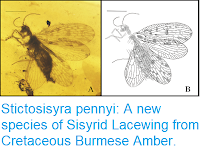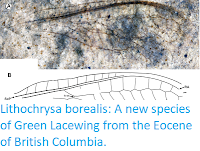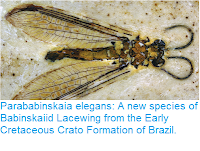The Babinskaiidae are an extinct family of Lacewings (Neuroptera) best
known from the Early Cretaceous Crato Formation of Brazil, as well as
from the Zaza Formation of southern Siberia and Burmese Amber deposits
from Kachin State, Myanmar. They are small Lacewings, with forewings
9-12.7 mm in length, differentiated from other groups by the venation of
their forewings (very few specimens have preserved hindwings). To date only nine species of Babinskaiid have been described, from the Early Cretaceous Crato Formation of Brazil and Zaza Formation of Russia, and from Middle Cretaceous Burmese Amber.
In a paper published in the journal ZooKeys on 4 April 2018, Jiahui Hu and Xiumei Lu of the Department of Entomology at the China Agricultural University, Bo Wang of the State Key Laboratory of Palaeobiology and Stratigraphy at the Nanjing Institute of Geology and Palaeontology of the Chinese Academy of Sciences, and Xingyue Liu, also of the Department of Entomology at the China Agricultural University, describe a new species of Babinskaiid Lacewing from Cretaceous Burmese Amber.
Cretaceous ‘Burmese Amber’ has been extensively worked at several sites
across northern Myanmar (though mostly in Kachin State) in the last 20
years. The amber is fairly clear, and often found in large chunks,
providing an exceptional window into the Middle Cretaceous Insect fauna.
This amber is thought to have started out as the resin of a Coniferous
Tree, possibly a Cypress or an Araucaria, growing in a moist tropical
forest. This amber has been dated to between 105 and 95 million years
old, based upon pollen inclusions, and to about 98.8 million years by
uranium/lead dating of ash inclusions in the amber.
The new species is placed in the genus Parababinskaia, which contains only one previously described species, from the Crato Formation of Brazil, and given the specific name makarkini, in honour of the entomologist Vladimir Makarkin, for his work on fossil Neuroptera. The new species is described from two specimens, a male and a female, in separate pieces of clear amber.
Parabinskaia makarkini, male specimen in dorsal view. Scale bar is 1.0 mm. Hu et al. (2018).
The male has a body length of 11.20 mm, and a forewing length of 11.11 mm, the female has a bodylength of 10.68 mm and a forewing length of 13.05 mm. Both have Both sexes have large, semi-globular compound eyes and two domed areas on the head. The thorax is robust, the legs long and the forewing broader than the hindwing.
Parabinskaia makarkini, female specimen in dorsal view. Scale bar is 1.0 mm. Hu et al. (2018).
See also...
Follow Sciency Thoughts on Facebook.








